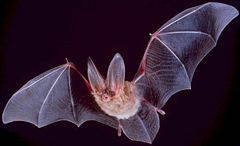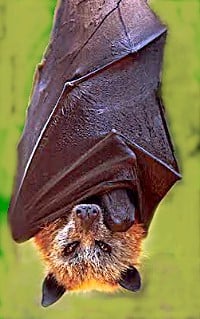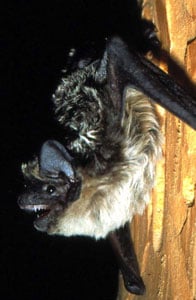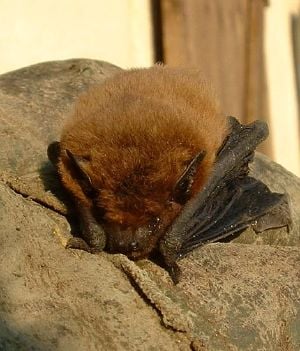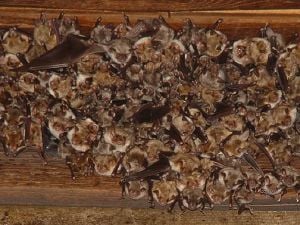Bat
| Bats | ||||||||
|---|---|---|---|---|---|---|---|---|
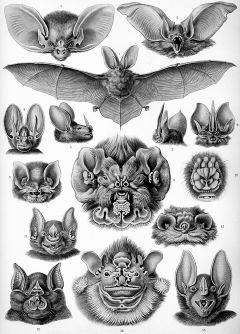 "Chiroptera" from Ernst Haeckel's Artforms of Nature, 1904 | ||||||||
| Scientific classification | ||||||||
| ||||||||
| Suborders | ||||||||
|
Megachiroptera |
Bats are mammals in the order Chiroptera. Their most distinguishing feature is that their forelimbs are developed as wings, making them the only mammal capable of flight. (Other mammals, such as flying squirrels and gliding phalangers, can glide for limited distances but are not capable of true flight). The word Chiroptera can be translated from the Greek words for "hand wing," as the structure of the open wing is very similar to an outspread human hand, with a membrane (patagium) between the fingers that also stretches between hand and body.
There are estimated to be about 1,100 species of bats worldwide: about 20% of all mammal species.
About 70 percent of bats are insectivorous. Most of the remainder feed on fruits and their juices; three bat species eat blood and some prey on vertebrates. These bats include the leaf-nosed bats (Phyllostomidae) of central America and South America, and the related bulldog bats (Noctilionidae) that feed on fish. There are at least two known species of bat that feed on other bats: the Spectral Bat or American False Vampire bat and the Ghost Bat of Australia.
Some of the smaller bat species are important pollinators of some tropical flowers. Indeed, many tropical plants are now found to be totally dependent on them, not just for pollination, but for spreading their seeds by eating the resulting fruits. This role explains environmental concerns when a bat is introduced in a new setting. Tenerife provides a recent example with the introduction of the Egyptian bat.
Classification
Bats are mammals. Though sometimes called "flying rodents", "flying mice," or even bugs, but bats are neither mice nor rodents. There are two suborders of bats:
- Megachiroptera (megabats)
- Microchiroptera (microbats/echolocating bats)
Despite the name, not all megabats are larger than microbats. The major distinction between the two suborders is based on other factors:
- Microbats use echolocation, whereas megabats do not (except for Rousettus and relatives, which do).
- Microbats lack the claw at the second toe of the forelimb.
- The ears of microbats don't form a closed ring, but the edges are separated from each other at the base of the ear.
- Microbats lack underfur; they have only guard hairs or are naked.
Megabats eat fruit, nectar or pollen while microbats eat insects, blood (small quantities of blood of animals), small mammals, and fish, relying on echolocation for navigation and finding prey.
Genetic evidence, however, indicates that some microbats ("Yinochiroptera") are more closely related to megabats than to the other microbats ("Yangochiroptera"). There is some morphological evidence that Megachiroptera evolved flight separately from Microchiroptera; if so, the Microchiroptera would have uncertain affinities. When adaptations to flight are discounted in a cladistic analysis, the Megachiroptera are allied to the primates by anatomical features that are not shared with Microchiroptera.
Little is known about the evolution of bats, since their small, delicate skeletons do not fossilize well. However a late Cretaceous tooth from South America resembles that of an early Microchiropteran bat. The oldest known definite bat fossils, such as Icaronycteris, Archaeonycteris, Palaeochiropteryx and Hassianycteris, are from the early Eocene (about 50 million years ago), but they were already very similar to modern microbats. Archaeopteropus, formerly classified as the earliest known megachiropteran, is now classified as a microchiropteran.
Bats are traditionally grouped with the tree shrews (Scandentia), colugos (Dermoptera), and the primates in superorder Archonta because of the similarities between Megachiroptera and these mammals. However, molecular studies have placed them as sister group to Ferungulata, a large grouping including carnivorans, pangolins, odd-toed ungulates, even-toed ungulates, and whales.
- ORDER CHIROPTERA (Ky-rop`ter-a) (Gr. cheir, hand, + pteron, wing)
- Suborder Megachiroptera (megabats)
- Pteropodidae
- Suborder Microchiroptera (microbats)
- Superfamily Emballonuroidea
- Emballonuridae (Sac-winged or Sheath-tailed bats)
- Superfamily Rhinopomatoidea
- Rhinopomatidae (Mouse-tailed bats)
- Craseonycteridae (Bumblebee Bat or Kitti's Hog-nosed Bat)
- Superfamily Rhinolophoidea
- Rhinolophidae (Horseshoe bats)
- Nycteridae (Hollow-faced or Slit-faced bats)
- Megadermatidae (False vampires)
- Superfamily Vespertilionoidea
- Vespertilionidae (Vesper bats or Evening bats)
- Superfamily Molossoidea
- Molossidae (Free-tailed bats)
- Antrozoidae (Pallid bats)
- Superfamily Nataloidea
- Natalidae (Funnel-eared bats)
- Myzopodidae (Sucker-footed bats)
- Thyropteridae (Disk-winged bats)
- Furipteridae (Smoky bats)
- Superfamily Noctilionoidea
- Noctilionidae (Bulldog bats or Fisherman bats)
- Mystacinidae (New Zealand short-tailed bats)
- Mormoopidae (Ghost-faced or Moustached bats)
- Phyllostomidae (Leaf-nosed bats) This family contains (among others) the Vampire bats
- Superfamily Emballonuroidea
- Suborder Megachiroptera (megabats)
Most microbats are active at night or at twilight. By emitting high-pitched sounds and listening to the echoes, the microbats locate prey and other nearby objects. This is the process of echolocation, a skill they share with dolphins and whales. But although the eyes of most species of microbats are small and poorly developed, the sense of vision is still functional, especially at long distances, beyond the range of echolocation. Their senses of smell and hearing, however, are excellent. A few moths have exploited the bat's senses; in one group (the tiger moths), the moths produce ultrasonic signals to warn the bats that the moths are chemically-protected (aposematism) (this was once thought to be a form of "radar jamming", but this theory has been disproved); in the other group (Noctuidae) the moths have a type of hearing organ called a tympanum which responds to an incoming bat signal by causing the moth's flight muscles to twitch erratically, sending the moth into random evasive maneuvers.
The teeth of microbats resemble those of the insectivorans. They are very sharp in order to bite through the hardened armour of insects or the skin of fruits.
Megabats are primarily fruit- or nectar-eating. They have, however, probably evolved for some time in New Guinea without microbat concurrention. This has resulted in some smaller megabats of the genus Nyctimene becoming (partly) insectivorous to fill the vacant microbat ecological niche. Furthermore, there is some evidence that the fruit bat genus Pteralopex, which occurs in the Solomon Islands, and its close relative Mirimiri from Fiji, have evolved to fill some niches that were open because there are no nonvolant mammals in those islands.
While other mammals have one-way valves only in their veins to prevent the blood from flowing backwards, bats also have the same mechanism in their arteries.
The finger bones of a bat are much more flexible than those of other mammals. One reason is that the cartilage in their fingers lacks calcium and other minerals nearer the tips, increasing their ability to bend without splintering. The cross section of the finger bone is also flattened instead of circular as is the bone in a human finger, making it even more flexible. The skin on their wing membranes is a lot more elastic and can stretch much more than what is usually seen among mammals.
Because their wings are much thinner than those of birds, bats can maneuver more quickly and more precisely than birds. The surface of their wings are also equipped with touch-sensitive receptors on small bumbs called "Merkel cells", which is found in most mammals, including humans. But these sensitive areas are different in bats as there are a tiny hair in the center, making it even more sensitive and detects and collects information about the air flowing over the wings. Another kind of receptor cells are found in the wing membrane in species who are using their wings to catch prey, and is sensitive to the stretching of the membrane. These cells are concentrated in the areas of the membrane where insects hits the wings when the bats captures them. Bats are not blind.
Reproduction
Mother bats usually have only one offspring per year. A baby bat is referred to as a pup. Pups are usually left in the roost when they are not nursing. However, a newborn bat can cling to the fur of the mother like pouch and be transported, although they soon grow too large for this. It would be difficult for an adult bat to carry more than one young, but normally only one young is born. Bats often form nursery roosts, with many females giving birth in the same area, be it a cave, a tree hole, or a cavity in a building. Mother bats are able to find their young in huge colonies of millions of other pups. Pups have even been seen to feed on other mothers' milk if their mother is dry. Only the mother cares for the young, and there is no continuous partnership with male bats.
The ability to fly is congenital, but after birth the wings are too small to fly. Young microbats become independent at the age of 6 to 8 weeks, megabats not until they are four months old. At the age of two years bats are sexually mature.
Habits and behavior
Bats vary in social structure, with some bats leading a solitary life and others living in caves colonized by more than a million bats.
The fission-fusion social structure is seen among several species of bats. The fusion part is all the individuals in a roosting area. The fission part is the breaking apart and mixing of subgroups by switching roosts with bats, ending up with bats in different trees and often with different roostmates.
Studies also show that bats make all kinds of sounds to communicate with each other. Scientists in the field have listened to bats and have been able to identify some sounds with some behavior bats will make right after the sounds are made.
Vectors for pathogens
Bats are natural reservoirs or vectors for a large number of zoonotic pathogens including rabies, SARS, Nipah virus, West Nile virus and possibly ebola virus. Their high mobility, broad distribution, social behaviour (communal roosting, fission-fusion social structure) and close evolutionary relationship to humans make bats favourable hosts and disseminators of disease. Many species also appear to have a high tolerance for habouring pathogens and often do not develop disease while infected.
The following advice is only relevant to areas with endemic rabies.
Only 0.5% of bats carry rabies. However, of the very few cases of rabies reported in the United States every year, most are caused by bat bites. Although most bats do not have rabies, those that do may be clumsy, disoriented, and unable to fly, which makes it more likely that they will come into contact with humans. Although one should not have an unreasonable fear of bats, one should avoid handling them or having them in one's living space, as with any wild animal. If a bat is found in living quarters near a child, mentally handicapped person, intoxicated person, sleeping person, or pet, the person or pet should receive immediate medical attention for rabies. Bats have very small teeth and can bite a sleeping person without necessarily being felt.
If a bat is found in a house and the possibility of exposure cannot be ruled out, the bat should be sequestered and an animal control officer called immediately, so that the bat can be analyzed. This also applies if the bat is found dead. If it is certain that nobody has been exposed to the bat, it should be removed from the house. The best way to do this is to close all the doors and windows to the room except one to the outside. The bat should soon leave.
Due to the risk of rabies and also due to health problems related to their guano, bats should be excluded from inhabited parts of houses. For full detailed information on all aspects of bat management, including how to capture a bat, what to do in case of exposure, and how to bat-proof a house humanely, see the Centers for Disease Control's website on bats and rabies. In certain countries, such as the UK, it is illegal to handle bats without a license.
Where rabies is not endemic, as throughout most of western Europe, small bats can be considered as harmless. Larger bats can give a nasty bite. Treat them with the respect due to any wild animal.
Cultural aspects
The bat is sacred in Tonga and West Africa and is often considered the physical manifestation of a separable soul. Bats are closely associated with vampires, who are said to be able to shapeshift into bats, fog or wolves. Bats are also a symbol of ghosts, death and disease. Among some Native Americans, such as the Creek, Cherokee and Apache, the bat is a trickster spirit. Chinese lore claims the bat is a symbol of longevity and happiness, and is similarly lucky in Poland and geographical Macedonia and among the Kwakiutl and Arabs.
In Western Culture, the bat is often a symbol of the night and its foreboding nature. The bat is a primary animal associated with fictional characters of the night such as both villains like Dracula and heroes like Batman. The association of the fear of the night with the animal was treated as a literary challenge by Kenneth Oppel, who created a best selling series of novels, beginning with Silverwing, which feature bats as the central heroic figures much in a similar manner as the classic novel Watership Down did for rabbits. An old wives' tale has it that bats will entangle themselves in people's hair. A likely root to this myth is that insect-eating bats seeking prey may dive erratically toward people, who attract mosquitoes and gnats, leading the squeamish to believe that the bats are trying to get in their hair.
In the United Kingdom all bats are protected under the Wildlife and Countryside Acts, and even disturbing a bat or its roost can be punished with a heavy fine.
Austin, Texas is the summer home to North America's largest urban bat colony, an estimated 1,500,000 Mexican free-tailed bats, who eat an estimated 10,000 to 30,000 pounds of insects each night and attract 100,000 tourists each year.
ReferencesISBN links support NWE through referral fees
- Greenhall, Arthur H. 1961. Bats in Agriculture. A Ministry of Agriculture Publication. Trinidad and Tobago.
- Nowak, Ronald M. 1994. " Walker's BATS of the World". The John Hopikins University Press, Baltimore and London.
- John D. Pettigrew's summary on Flying Primate Hypothesis
See also
- European Bat Night
- Bat bomb
- Batman
- Bat World Sanctuary
- Fictional bats
External links
- Arkansas Bat Rescue Network
- United States Bat Rescue
- Bat Conservation International website
- Bat World Sanctuary
- Texas Parks and Wildlife Bat Page
- University of Michigan Museum of Zoology
- Tree of Life
- Flying Fur
- Bats make up 20% of mammals
- The Bat Conservation Trust
- Adopt-a-Bat
- Organization for Bat Conservation
- Illustrated Identification key to the (micro)bats of Europe (see "Recent publications")
- Lubee Bat Conservancy
- Bats from Brazil
- U.S. Cavers Forum - Bats
- General text on bats
| Mammals |
|---|
| Monotremata (platypus, echidnas) |
|
Marsupialia: | Paucituberculata (shrew opossums) | Didelphimorphia (opossums) | Microbiotheria | Notoryctemorphia (marsupial moles) | Dasyuromorphia (quolls and dunnarts) | Peramelemorphia (bilbies, bandicoots) | Diprotodontia (kangaroos and relatives) |
|
Placentalia: Cingulata (armadillos) | Pilosa (anteaters, sloths) | Afrosoricida (tenrecs, golden moles) | Macroscelidea (elephant shrews) | Tubulidentata (aardvark) | Hyracoidea (hyraxes) | Proboscidea (elephants) | Sirenia (dugongs, manatees) | Soricomorpha (shrews, moles) | Erinaceomorpha (hedgehogs and relatives) Chiroptera (bats) | Pholidota (pangolins)| Carnivora | Perissodactyla (odd-toed ungulates) | Artiodactyla (even-toed ungulates) | Cetacea (whales, dolphins) | Rodentia (rodents) | Lagomorpha (rabbits and relatives) | Scandentia (treeshrews) | Dermoptera (colugos) | Primates | |
Credits
New World Encyclopedia writers and editors rewrote and completed the Wikipedia article in accordance with New World Encyclopedia standards. This article abides by terms of the Creative Commons CC-by-sa 3.0 License (CC-by-sa), which may be used and disseminated with proper attribution. Credit is due under the terms of this license that can reference both the New World Encyclopedia contributors and the selfless volunteer contributors of the Wikimedia Foundation. To cite this article click here for a list of acceptable citing formats.The history of earlier contributions by wikipedians is accessible to researchers here:
The history of this article since it was imported to New World Encyclopedia:
Note: Some restrictions may apply to use of individual images which are separately licensed.
